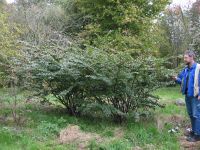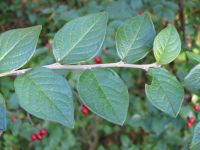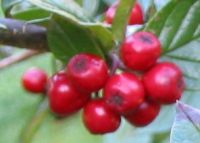Cotoneaster species - Cotoneaster hualiensis
English name:
Cotoneaster species
Scientific name:
Cotoneaster hualiensis
Family:
Rosaceae (Rose family)
Height:
up to 2 m. in Hørsholm Arboretum
Flowering:
Late May to July
Range:
Taiwan
 |
|
 |
 |
The Cotoneaster hualiensis in the picture can be found on the east side of the Lake road of the Arboretum, in square 1013 position 3601.
Plant description:
The genus Cotoneaster is reported to contain about 260 species. The name of the genus comes from Cotonea refering to Cydonia (Quince) and aster means kind of, because the leaves of some species resemble Quince leaves. However the genus is more closely related to the genus Crataegus. Cotoneaster has a natural range across Europe, North Africa, and Asia but does not occur in Japan. The genus contains deciduous or evergreen shrubs, and rarely small trees. Plants in this species are mainly used as ornamentals mainly because of the attractive fruits. One species reported to be a source of a sweet manna-like substance high in dextrose used in Iran and India. Many species are apomictic, that is they produce seed without fertilization. We have about 28 species of Cotoneaster, growing in our collection in Hørsholm and 5 examples of Cotoneaster hualiensis.
This species was described in 2001 by J. Fryer and B. Hylmo in an article in: The New Plantsman (see references below). Based on this article we have just changed the name of our plants from Cotoneaster konishii to Cotoneaster hualiensis. This species is reported to have three sets of chromosomes (51 in all) and is apomictic. All of our 5 specimens are quite uniform, consistent with the seed being produced without fertilization. All specimens that we possess are from one collection of seed made in Nantou County in Taiwan. The seeds were donated in 1990 by the Botanic Garden of the Forest Research Institute, Taipai Taiwan.
This species is rather new to cultivation in Europe and is still a little difficult to obtain, but has the potential to be an outstanding garden plant in Denmark, judging from its performance in the few years it has been planted out in the Hørsholm Arboretum. Nevertheless, one of our plants has died showing the classic symptoms of infection by honey fungus (Armillaria). The dark green leaves and bright red fruit give an impressive display in early October. The leaves fall later in the month after turning intensively red. Although a little experimental, because it has not been tested for so long in the Danish climate, I think this is a plant to be recommended.
The branches are erect, arched and spreading; the new shoots are covered with dense hair, as are the buds. The leaves are alternate on the twigs, dark green on top with an uneven surface and impressed veins. The petiole is pubescent (strongly hairy). Seen from below the leaves are notably hairy and the veins are raised beneath. On infertile shoots the leaves are arranged in one plain. The fruit is blood red and shiny contrasting well with the dark green leaves. The fruit contain 3 to 5 seeds each in contrast to Cotoneaster konishii where only two seeds per fruit are found.
References:
Fryer, J. & Hylmo, B. 2001. Captivating Cotoneasters. The New Plantsman 8: 227-238.
Li, H. I. 1963. Woody Flora of Taiwan. Livingston Publishing Company, Narberth, Pennsylvania. P 270.
Mabberley, D.J. 1997. The Plant Book. Cambridge University Press, Cambridge, UK. Pp 51.
